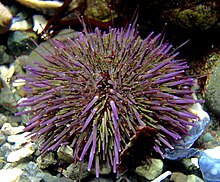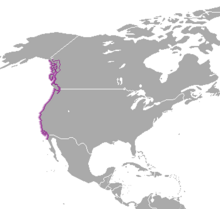Purple sea urchin
| Strongylocentrotus purpuratus | |
|---|---|
 |
|
| Scientific classification | |
| Kingdom: | Animalia |
| Phylum: | Echinodermata |
| Class: | Echinoidea |
| Subclass: | Euechinoidea |
| Superorder: | Echinacea |
| Order: | Echinoida |
| Family: | Strongylocentrotidae |
| Genus: | Strongylocentrotus |
| Species: | S. purpuratus |
| Binomial name | |
|
Strongylocentrotus purpuratus (Stimpson, 1857) |
|
 |
|
| Strongylocentrotus purpuratus range | |
The purple sea urchin, Strongylocentrotus purpuratus, lives along the eastern edge of the Pacific Ocean extending from Ensenada, Mexico to British Columbia, Canada. This sea urchin species is deep purple in color, eggs are orange when secreted in water, and lives in lower inter-tidal and nearshore sub-tidal communities. January, February, and March function as the typical active reproductive months for the species. Sexual maturity is reached around two years.
It normally grows to a diameter of about 4 inches and may live as long as 70 years.
While embryonic development is still a major part of the utilization of the sea urchin, studies on urchin's position as an evolutionary marvel have become increasingly frequent. Orthologs to human diseases have led scientists to investigate potential therapeutic uses for the sequences found in Strongylocentrotus purpuratus. For instance, in 2012, scientists at the University of St Andrews began investigating the "2A" viral region in the S. purpuratus genome which may be useful for Alzheimer's disease and cancer research. The study identified a sequence that can return cells to a 'stem-cell' like state, allowing for better treatment options. The species has also been a candidate in longevity studies, particularly because of its ability to regenerate damaged or aging tissue. Another study comparing 'young' vs. 'old' suggested that even in species with varying lifespans, the 'regenerative potential' was upheld in older specimens as they suffered no significant disadvantages compared to younger ones.
Its genome was completely sequenced and annotated in 2006 by teams of scientists from over 70 institutions including the Kerckhoff Marine Laboratory at the California Institute of Technology as well as the Human Genome Sequencing Center at the Baylor College of Medicine.Strongylocentrotus purpuratus is one of several biomedical research models in cell and developmental biology. The sea urchin is the first animal with a sequenced genome that (1) is a free-living, motile marine invertebrate; (2) has a bilaterally organized embryo but a radial adult body plan; (3) has the endoskeleton and water vascular system found only in echinoderms; and (4) has a nonadaptive immune system that is unique in the enormous complexity of its receptor repertoire.
...
Wikipedia
